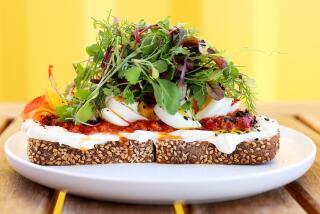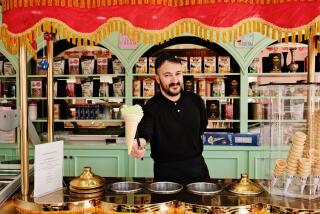The Crossroads of Europe and Asia
- Share via
ISTANBUL, Turkey — Once described as a comely bride adorned enticingly for her husband, this color-splashed city is more than that, being a fetching combination of earth mother, saucy soubrette, harridan and grand dame at the doorway of Asia Minor.
With one foot in Europe and the other in Asia, Istanbul’s setting at the confluence of the Sea of Marmara, Golden Horn and Bosporus, is unrivaled by any other city--Rio de Janeiro, San Francisco and Naples included.
Istanbul’s checkered history and changing fate began as a fishing village about 1000 BC. It became the Greek Byzantium a few centuries later and, after accepting Rome’s influence and fighting wars between the empire’s various factions, it fell to Constantine the Great and Christianity in AD 330.
He proclaimed it “New Rome,” renamed it Constantinople and made it capital of the Eastern Roman (Byzantine) Empire until conquered by Ottoman Turks in 1453.
Understanding Istanbul’s past helps to appreciate the city’s attractions today: bits of Greek statuary; Roman forums, hippodrome and aqueduct; majestic Ottoman palaces, the great Christian church-Muslim mosque of St. Sophia.
These and other priceless legacies from Hellenic, Christian and Muslim eras have made the city an exciting first step into a country that yearly lures great numbers of visitors from around the world.
Getting here: Fly British Airways, Pan Am, Lufthansa, KLM or SAS.
How long/how much? Four days will keep you hopping, what with a day’s cruise up the Bosporus for lunch near the Black Sea and perhaps another day over to Bursa for a look at the Asian side. Lodging costs are expensive, but great Turkish food is a huge bargain.
A few fast facts: The Turkish lira recently sold at 2,200 to the dollar, about .00045 each. Visit any time from spring through November. Cabs are reasonable and the town has 17,000 of them, but make sure you get one with a meter. And stick to bottled water, even in the best hotels.
Getting settled in: Hotel Gezi (Mete Caddesi 42; $74 to $97 double B&B;) has a wonderful location, with fine views of the city and Bosporus. Bedrooms are contemporary in decor, and there are sparkling marble baths, mini-bars and TV.
The Hotel Riva (Aydede Caddesi 8; $95 B&B; double), like most hotels, is on the “newer” Beyoglu side of the Golden Horn. It’s modern, with a restaurant cantilevered over the lobby on a balcony. Bedrooms are neat, basic and on the small side. The cellar breakfast room serves as the Riva Pub in the evening.
Hotel Eresin (Topcu Caddesi 34; $100 B&B; double), at the heart of Beyoglu, has a pleasant marble lobby. While the bedrooms are also small, they’re pretty, bright and have all the big hotel amenities. Buffet breakfasts there are more like a hearty brunch.
Regional food and drink: You’ll find plenty of lamb and fresh seafood, but some of the more interesting specialties never make it out of the country. Try the pedici-- a flat, pita-like bread topped with cheese, ground meat or eggs, then baked. Lahmacun also uses pita bread as a base for a soft pizza delight that’s inexpensive.
Turks have at least 150 ways of preparing eggplant and all are colorful and delicious, like most of their fresh vegetable dishes. Cankaya is a good white wine from the Ankara region. Doluca Akik Beyoz also is excellent.
Dining well: Pandeli (above the Spice Market by the Galata Bridge) has achieved a worldwide reputation for authentic Turkish food in a romantic setting overlooking the Bosporus. Everything we had was luscious: fried mussels, kebabs on eggplant, lamb shish kebab and koftes (a spicy lamb patty). Menus have English translations, and most main dishes are $3-$5.
Akvaryum (Capariz Sok. 39) is one of about 35 small fish places in the Kumkapi area of the old part of town, southwest of the Golden Horn. Just look for the word balik , which means “fish,” over the door, then go in for the very best seafood. Try Akvaryum’s swordfish kebab skewered with fresh bay leaf. At night the area comes alive with street musicians, which you invite inside to play, and then tip. Some groups even bring along their own belly dancer.
Palet No. 3 (Tarabaya village on Bosporus) is about a 20-mile cab ride from Istanbul. Or take a ferry from the Galata Bridge, but make sure you get Palet No. 3. It’s on a small marina, open to the street, offering music in the evenings. The mezes (hors d’oeuvres) are numerous, the main dishes superb.
Going first-class: In the last three decades the Hilton (Cumhuriyet Caddesi; $145-$170 double) has become a showplace and social center, with probably the finest view in the city. Its lobby is also the best people-watching spot in town: women in purdah, sheiks in flowing robes, European industrialists meeting for drinks.
The Hilton has every possible luxury, from pool and squash court to helicopter pad. The rooftop Rotisserie is considered Istanbul’s most chic dining spot, and it served us the best meal we had had since the French Riviera. Stop by for a drink in the Rotisserie’s Kiz Kulesi Bar.
Established in 1892 to accommodate passengers of the Orient Express, the Pera Palace (Mesrutiyet Caddesi 98; $148 double) has a guest book that runs the gamut from Kemal Ataturk to Agatha Christie. The main lounge is a masterwork of wood paneling and marble soaring up to glass cupolas in the ceiling.
A club-like bar has an antique chandelier, a cool terrace and a 78 rpm Victrola. Everything about the Pera Palace whisks you back to the last century, but the busy lobby is cluttered with tour desks, posters and other tacky paraphernalia.
Yesil Ev (Kabasakal Caddesi 5; $120 double) is one of the last 19th-Century Ottoman mansions, now converted into a magnificent hotel. It’s in the old part of town near St. Sophia, Topkapi Palace and the Sultan Ahmet Mosque (Blue Mosque). Each bedroom has its own color scheme and period furnishings.
The Pasha’s Suite ($180) is a fantasy of white and gold baroque furniture, an Alexander Bell telephone that still works and private Turkish bath with marble massage table. Take your meals in the flowery garden beneath magnolia and fig trees by a tinkling fountain.
On your own: Start making a small dent in the city’s attractions by visiting the Blue Mosque, so called for its interior of blue tiles; Suleyman Mosque, begun in 1550 and probably the town’s most beautiful, and St. Sophia Museum, built by Emperor Constantine, later a mosque and finally desanctified by Kemal Ataturk.
Palaces come next. Spend an hour or so in Topkapi, where 24 kitchens (now displaying jewels and porcelains) once turned out meals for the 4,000 people who lived and worked there. Gigantic Dolmabahce Palace on the Bosporus also is worth a visit, but the lines are horrendous. So cross the Bosporus on the Ataturk Bridge and see the summer palace of Beylerbeyi, where the sultan and his harem went during hot months.
Take a ferry ride up to the Black Sea, visit the Turkish and Islamic Arts Museum and get lost in the bazaar looking for a Turkish carpet.
For more information: Call the Turkish Culture & Information Attache at (212) 687-2194, or write (821 United Nations Plaza, New York 10017) for a brochure-city map of Istanbul giving descriptions and locations of sights and many hotels.
More to Read
Sign up for The Wild
We’ll help you find the best places to hike, bike and run, as well as the perfect silent spots for meditation and yoga.
You may occasionally receive promotional content from the Los Angeles Times.






